Given how intertwined the history is between the Royal Canal and the Midlands Great Western Railway (MGWR) I think it would be remiss of me not to put up a post about the old MGWR Mullingar to Athlone railway line which has been converted into an amazing 40km greenway called the Old Rail Trail which is entirely in Westmeath.

I previously discussed running the Old Rail Trail from Athlone to Mullingar here but in the context of my series of guide posts of the Royal Canal I will revisit the topic here starting in Mullingar. A quick history lesson will tell you that the MGWR was incorporated in 1845 and at its peak was the third largest railway company in Ireland after Great Southern & Western Railway (GS&WR) and Great Northern Railway of Ireland (GNR). The MGWR bought the Royal Canal with the aim to build a railway to Mullingar and onward to Longford. Construction of the railway began in January 1846 and reached Mullingar in 1848.

There was a rivalry between the MGWR and the GS&WR to reach Galway first and so it was that the MGWR extended their line from Mullingar to Athlone and onward to Galway, capable of running trains from Dublin to Galway from August 1851. It would be another 8 years before GS&WR reached Athlone and from that point on used the already laid MGWR line west.

Starting at Mullingar Railway Station, the platforms and shelters of the old Athlone line are no longer in use or accessible. They sit around the far side of the station building and can only be viewed from inside. Also visible from the station building is the Signal Box on the Dublin side which commands view of both the Athlone and Sligo lines as they part either side of the station. The Athlone line through the station is still in place as far out as the railway sheds and workers terrace passing over a bridge immediately after the station. These sheds were used by the Railway Preservation Society of Ireland in the restoration of Great Southern & Western Railway Locomotive No. 184. This locomotive went on to be used in the filming of The First Great Train Robbery starring Sean Connery and Donald Sunderland where many moving scenes were shot on the Mulligar to Athlone railway line. No. 184 is on display at Whitehead Railway Museum in Co. Antrim. There is also the remains of a turntable out by the railway sheds. The workers terrace was also the location of a true crime in 1869 when it was reported that the then Station Master Thomas Anketell was shot and murdered and a newspaper article about the incident can be found here.
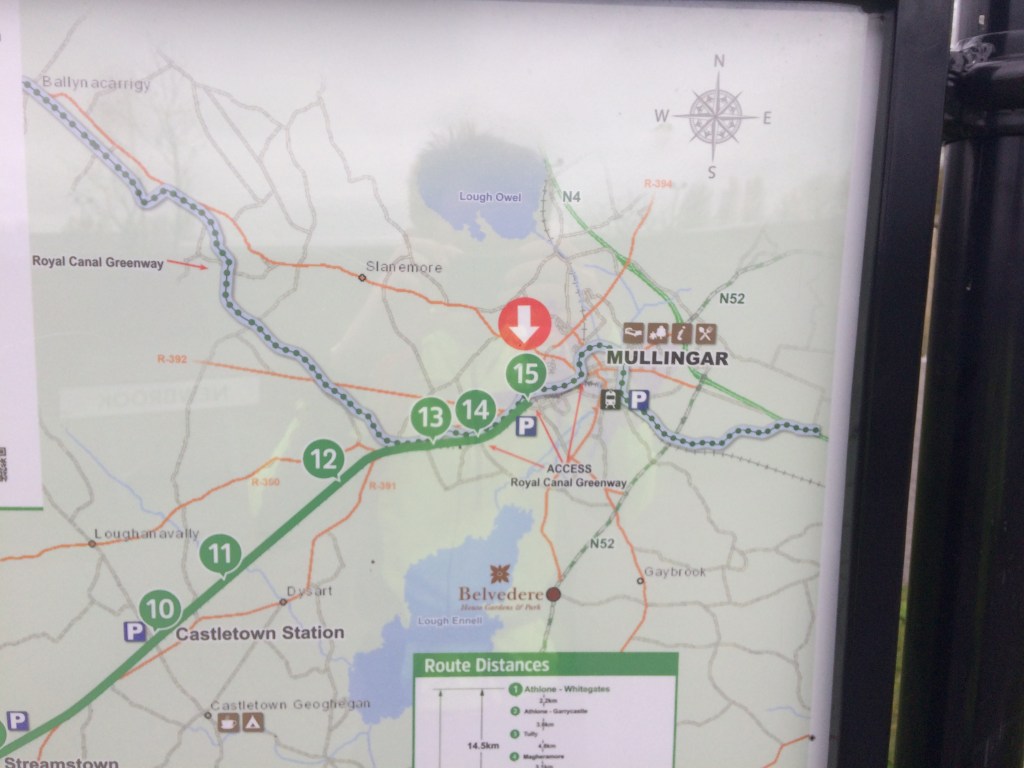
Unfortunately while we can view the sheds from a distance or on Google Maps we are unable to go directly by them so to access the start of the Old Rail Trail it is best to exit the station onto the Royal Canal Greenway and head west as far as Grange Bridge which was described by the late Dick Warner as like having the legs of a Mullingar heifer. Alternatively there is an Old Rail Trail car park adjacent to Grange Bridge on the south side of the canal.
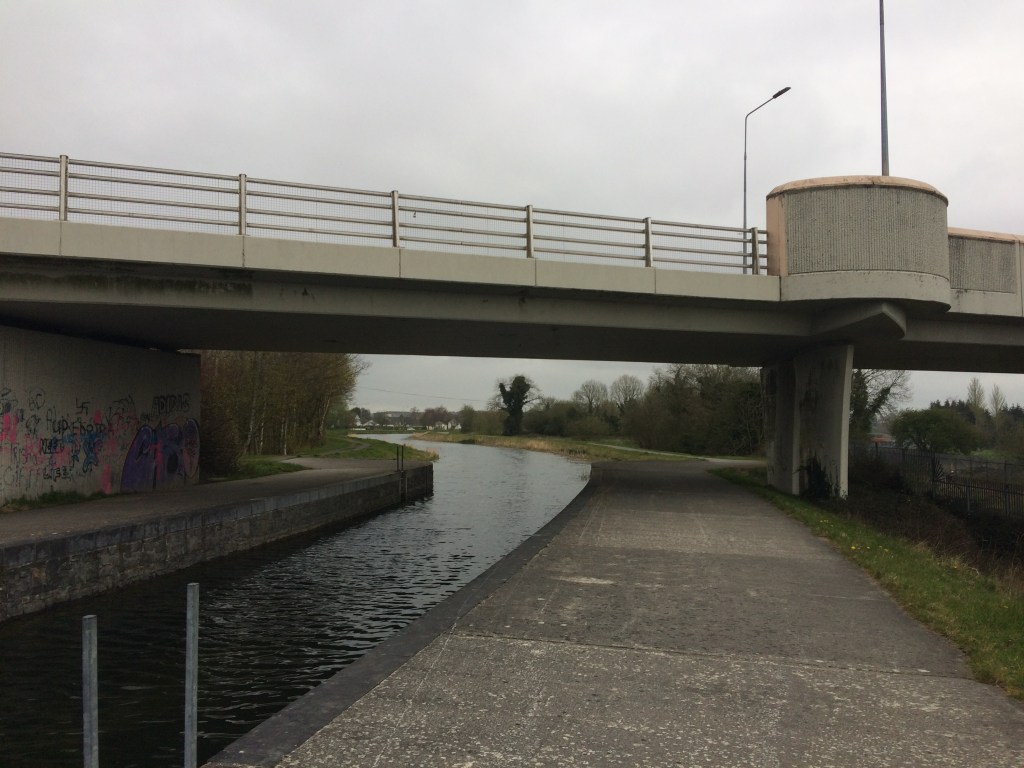
Just after passing Grange Bridge you will see that the Royal Canal Greenway splits in two. On the right you stay with the canal and the route as far as Coolnahay is described in my post here and on the left is the start of the Old Rail Trail. You will also see the start sign of Mullingar parkrun at the Y of the two greenways.
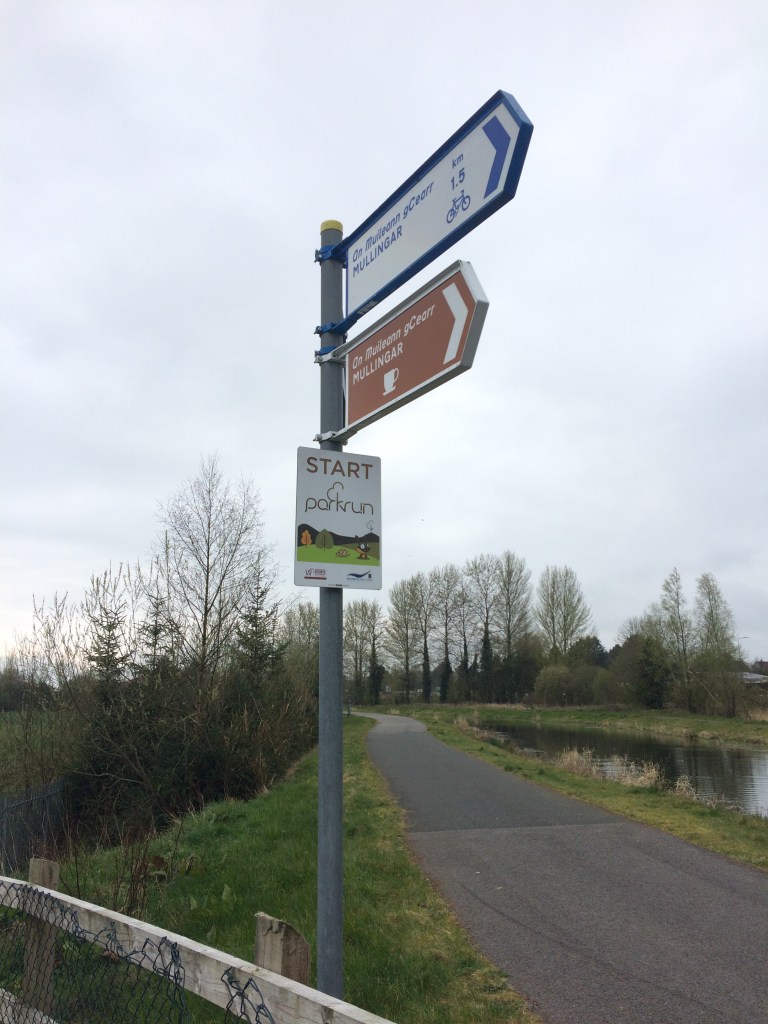
As you start moving west on the Old Rail Trail you will notice it is a smooth tarmac surface unlike the dust stone used on the Royal Canal Greenway. This tarmac surface is used the whole way to Athlone and as such makes it the perfect surface for a smooth cycle. Passing the industrial estate on the left you will notice the remains of a railway platform which was used to serve the Mullingar Racecourse at Newbrook. From what I can gather from Railscot’s record of Irish Stations the platforms operated from 1902 to 1962.

The Royal Canal Greenway and the Old Rail Trail run parallel to each other for roughly 3.5km from Grange Bridge out to Ballinea. The parkrun course is made up of an out on the canal and a return on the Old Rail Trail. Close to Kilpatrick Bridge over the canal there is also a squared off bridge over the trail.

Not far beyond Kilpatrick Bridge we come to the last link to the Royal Canal Greenway where the parkrun turns to go back to its finish. Just beyond that is also the last MGWR bridge that is abutted to an older Royal Canal bridge at Belmont Bridge. There is a small shop in Ballinea which you can get to by taking the Royal Canal here. If you haven’t come with supplies I would suggest taking the time to stop here and get something as Moate is the next location where you really have an opportunity to get anything.
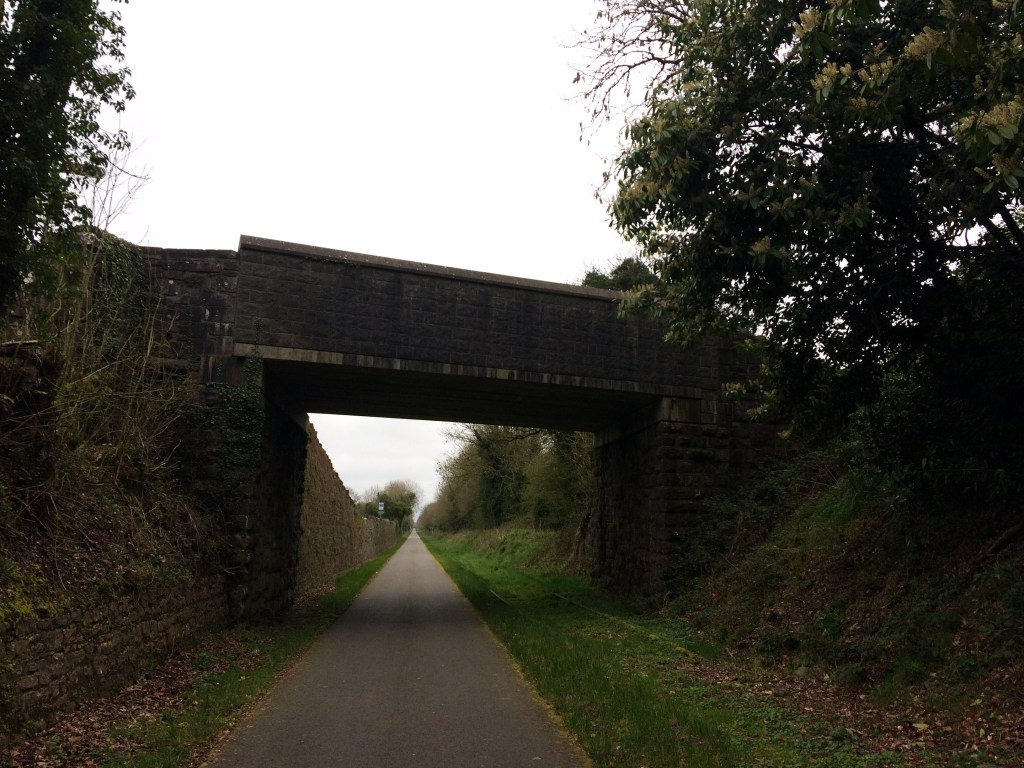
As can be seen in the above photo, the Old Rail Trail only takes up about half the surface available to it as it was once a double line track and as a result there is the remains of one of the tracks for the majority of the distance to Athlone to remind us of the proud rail heritage that the trail is built on.
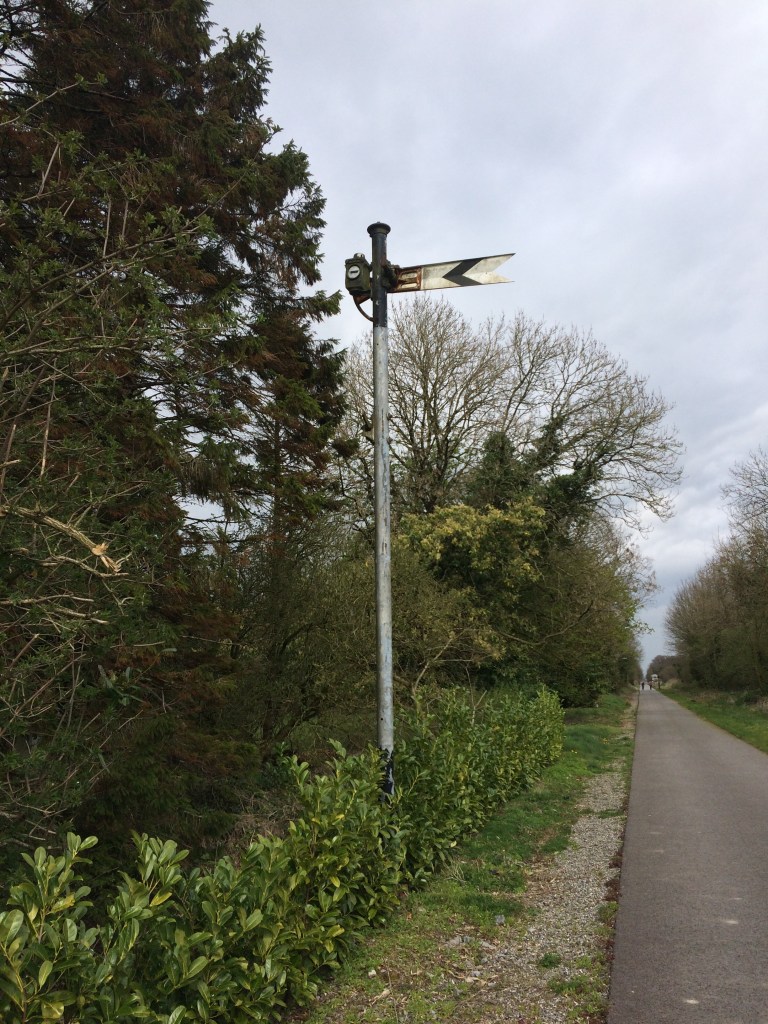
At Ballinea we pass a private residence that was most likely originally built as railway workers cottage. We have left the old world of the canal now, the familiar sights of Locks, Keeper’s Cottages and humpback bridges are replaced with the railways own take on engineering with workers cottages, stations, water towers and sheds all to come.

Not far west of Ballinea we pass through the closest thing to a tunnel the Old Rail Trail has. As we move further west in what is nearly a straight line we both go over and under many bridges alternating between the roads going over and under the railway. Unless they have some key relevance though I will only mention the bridges we pass under as it is near impossible to take a worthwhile photo of a bridge when standing on top of it.
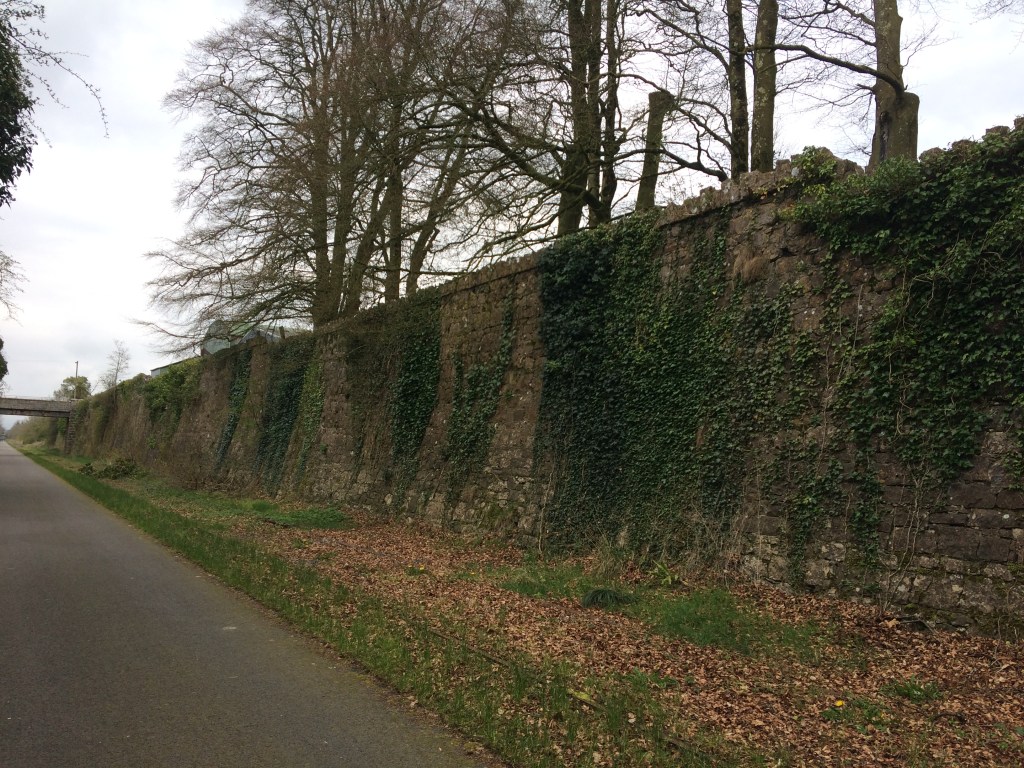
It is interesting as we move across the landscape how the railway would have cut through the land in places like at Barrettstown where high walls flank us on either side to soaring high above the farmland at other points affording us views as far as the eye can see, not to mention a wind that can cut you on a cold day so a reminder to always be prepared.
3.5km from Barrettstown we come to what was Castletown Station which was open from 1851 until 1987. The first thing to greet us is the magnificently restored signal box. Behind the signal box is Ard Na Greine, a Victorian house and former dispensary. Crossing over the road we come to the station and its platforms.

The Castletown Station is now a private residence on the northern platform but the southern platform does offer picnic benches for those passing by. As mentioned previously it is important to bring your own supplies on this trip, however, Castletown Geoghegan has a shop in it 2km south along the road if you need it.

Though boarded up the remains of a platform waiting room faces the station on the southern platform and to complete the station set there is the remains of a goods shed just west of the platforms as you are leaving.

Leaving Castletown behind us we head towards an area known as Killeen and the area around Jamestown Court, with its Gate Lodge adjacent to the bridge over the railway which acts an entrance into the estate and its folly. Unfortunately the splendour of Jamestown Court cannot be seen from the Old Rail Trail as it is cut into the land below it.
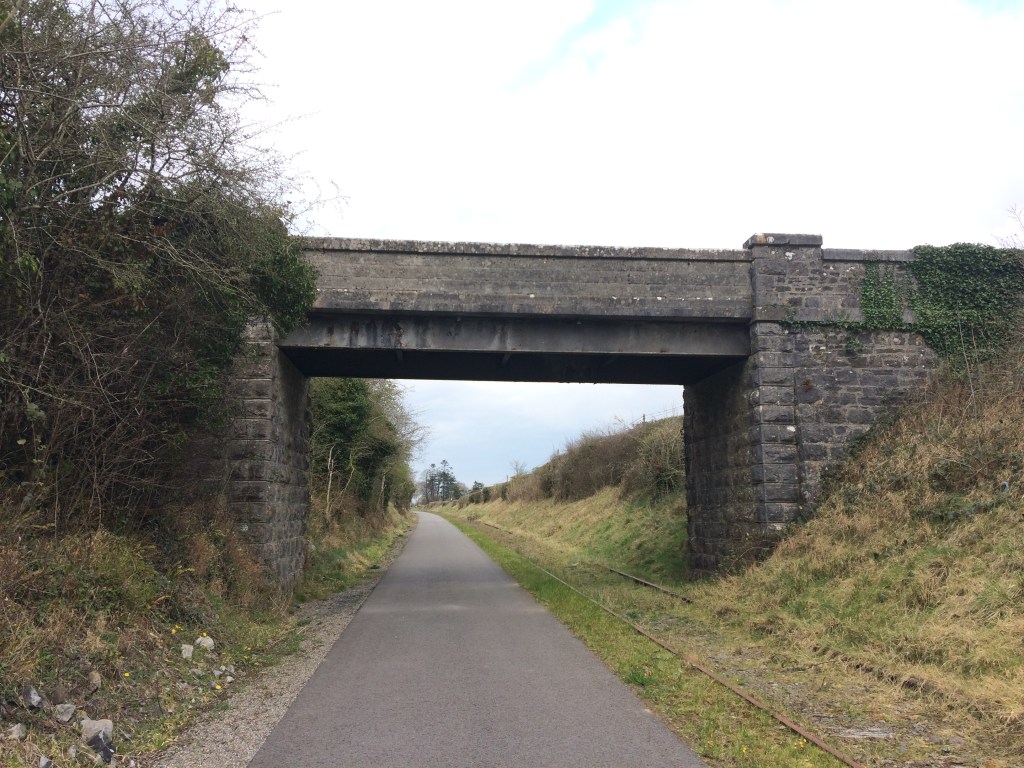
Just short of 4km from Jamestown Court we come to Streamstown Junction and its old station which opened in 1851 and closed in 1963. MGWR had a railway from Streamstown linking to the GS&WR at Clara via Horseleap. Horseleap was open from 1876 to 1947 with the line permanently closing in 1965. The MGWR station in Clara operated from 1866 to 1925 but what was the GS&WR station is still open on the line between Tullamore and Athlone.

Streamstown is located nearly half way along the Old Rail Trail, 17km from Mullingar and 23km to Athlone. The last time I passed (April 2019) there was an open air museum dedicated to old farm machinery on the northern platform.

The station building itself was also covered in scaffolding. I have heard rumours that it was being done with the intention of opening a cafe in it. This would be a fantastic point along the route for one but I have no definite source for such a comment so only time will tell. The work may just be preservation work. The station also has the remains of a few other buildings including a small goods shed and a waiting room.

Apart from the obvious railway and buildings along the route, many other things associated with the railway also remain. These include mile markers, signals and cable polls.

At certain points along the trail you cross over older bridges that once carried the railway over the road below but have not endured the test of time as well as others. Not far past Streamstown is one such example where the trail narrows slightly where the old bridge that once carried two lines has been fixed up just to safely carry the trail.
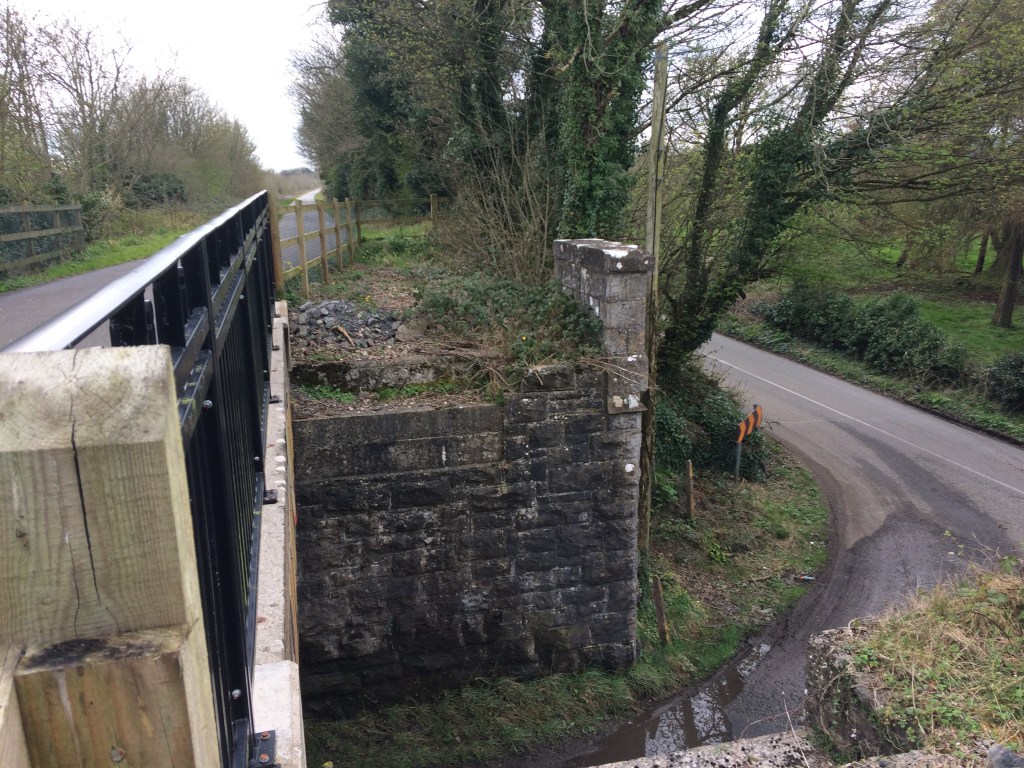
Not all the bridges we come to are built of the familiar limestone that we are used to along the canal. The next bridge up at Derryhall has a heavy metal work span over the trail, crossing at an angle rather than straight on.
It is an 11km stretch of open countryside between Streamstown and Moate and while it would be wrong to say it is flat, saying it is made up of rolling hills would not be fair either. Exposed at times, this rural area is quite a pleasant place to transit through dotted with little more than farmhouses, sheds and bridges.

Not too far after passing under the bridge at Grange we come to the largest urban settlement along the Old Rail Trail, the town of Moate.

Moate railway station opened in 1851 and closed in 1987. Like Castletown there are a large number of railway associated buildings and structures remaining as we pass through the station between the old platforms.

Moate is a great little town to stop off in and get some lunch with plenty on offer to suit all tastes and budgets. Right beside the train station you will see signs pointing you to the Moate Golf Course Restaurant. If you rather venture into the town a little you will find the coffee shop at the Tuar Ard Arts Centre and of course you can never go wrong with at curry cheese chips at Supermacs. There is also a Centra and a SuperValu not far from the station for whatever supplies you may need.

Leaving Moate behind us we only have another 12km to go to get us to Athlone. Not far from the station and still withing the town limits we come to Jones Crossing where the old Gate Keeper’s Cottage is now a private residence and the crossing gates are still in place.

Further west again we come to another level crossing at Magheramore where once again the Gate Keeper’s Cottage has been retained as a private residence.
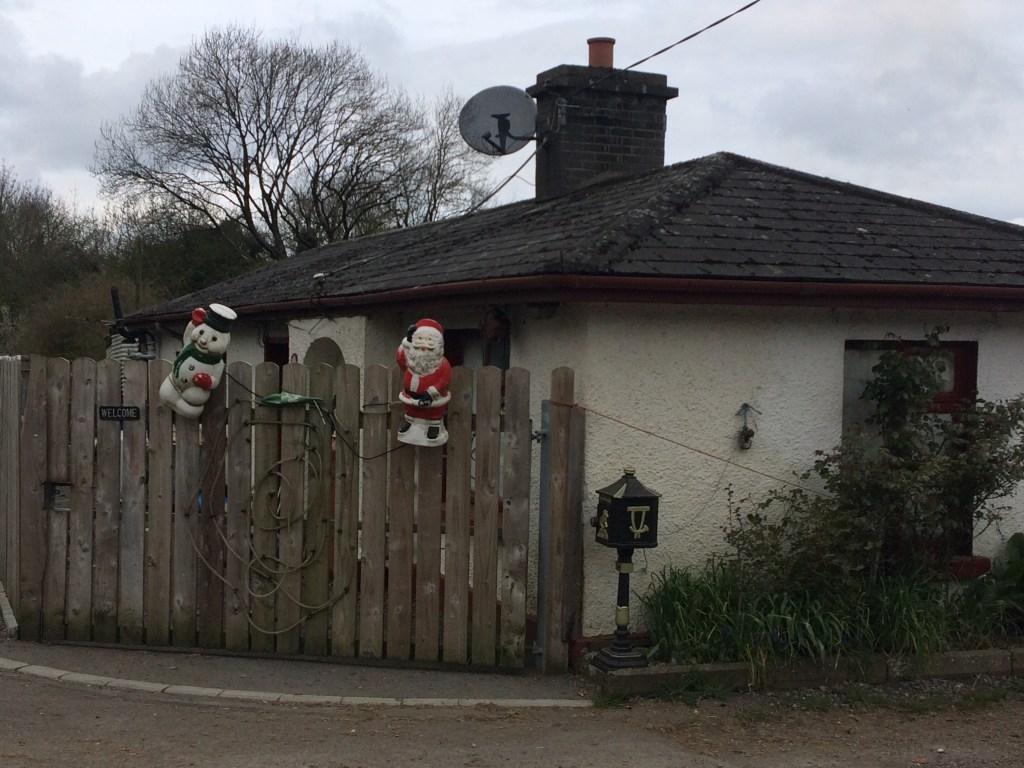
The section between Moate and Athlone is very people with the residents of both towns to get out and get some exercise in both directions. There is a car park located for Greenway users at Tully Bridge about half way between the two towns.

You are met on the outskirts of Athlone by the bridge carrying the N6 over the Old Rail Trail on its way to Galway from Dublin, the modern passing over the old, the rushed passing over the leisurely.

Much more welcoming than the N6 Bridge is the bridge a little further up at Garrycastle near Athlone I.T. with its colourful murals.


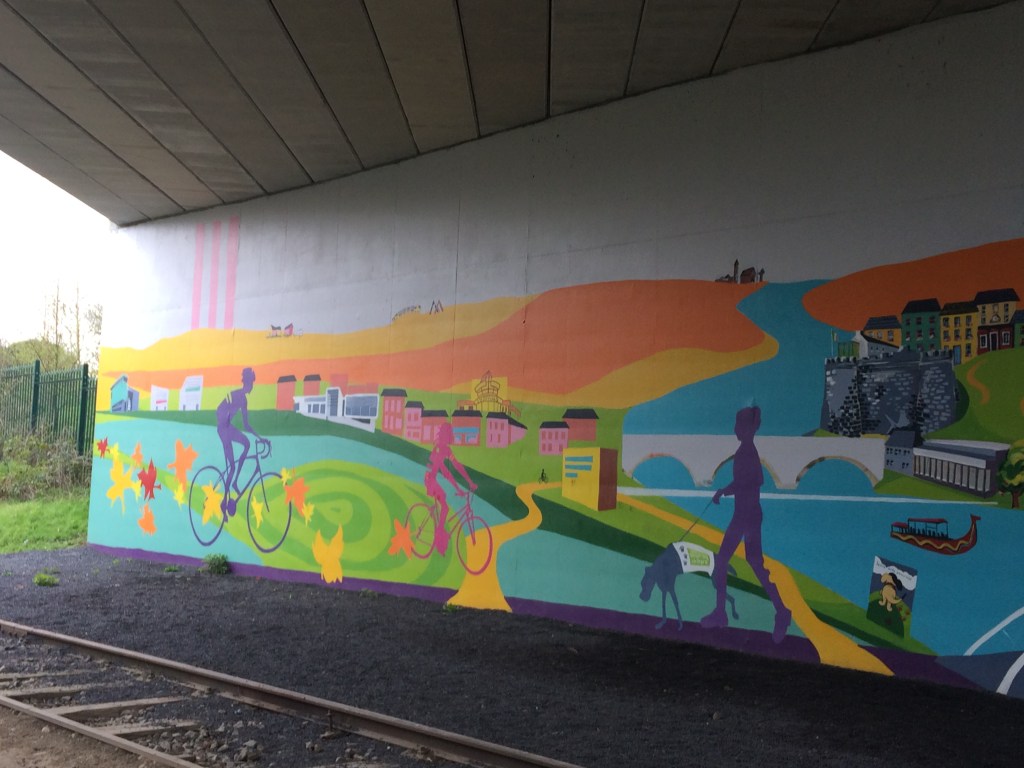

There is a large Spar with a car park just off the Old Rail Trail at Garrycastle offering another good place to fuel up and it includes a reasonable deli and a place to sit down to eat. The trail is has lighting from here the whole way into Athlone town and will probably be the busiest section you will come to. It is only 2km from here to our end point at the White Gates.

We pass Athlone GAA Club as we reach our destination at the White Gates after travelling the 40km from Grange Bridge at Mullingar. For the runners among you, add in the distance to Mullingar railway station and you will be looking a a nice marathon distance.

When I did this journey last the White Gates marked the start/end of the Old Rail Trail but the plan is that this will continue on from here the whole way to Galway to make up the Dublin – Galway Cycleway. Westmeath County Council are certainly to be commended for having their part already done.
Given I started at the MGWR railway station in Mullingar I think it is only right that I should mention the old MGWR railway station in Athlone. Only 600metres from the White Gates the old MGWR railway was joined by it the GS&WR railway coming from Hueston where crossed the Shannon together on the Shannon Railway Bridge before the MGWR Railway Station on the west bank of the river. The old station now serves as Irish Rail offices and stores while the GS&WR Railway Station on the east bank is the passenger station for Athlone. From there locomotives from both companies steamed west to Galway.
My posts about the Royal Canal Greenway can be linked to below:
Part 1: North Wall to Cross Guns Bridge
Part 2: Cross Guns Bridge to Castleknock
Part 3: Castleknock to Leixlip Confey
Part 4: Leixlip Confey to Maynooth
Part 7: Thomastown to Mullingar Harbour
Part 8: Mullingar to Coolnahay
Part 9: Coolnahay to Ballynacargy Bridge
Part 10: Ballynacargy to Abbeyshrule
Part 11: Abbeyshrule to Ballybrannigan
Part 12: Ballybrannigan to the 41st Lock
Part 13: 41st Lock to Richmond Harbour





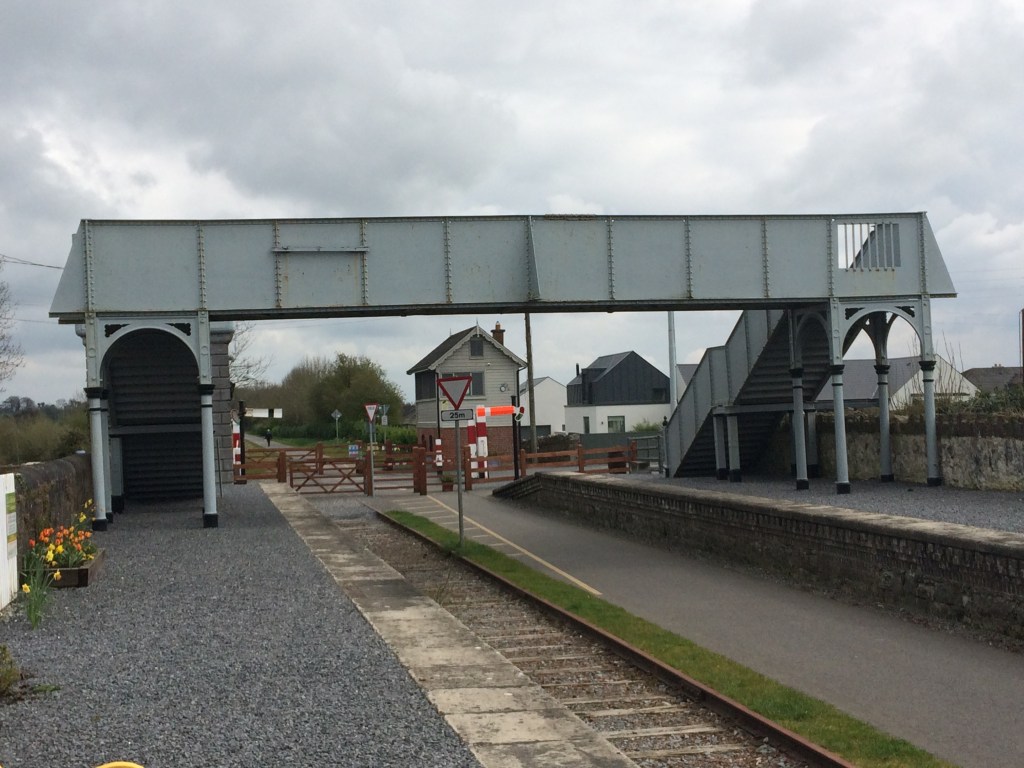

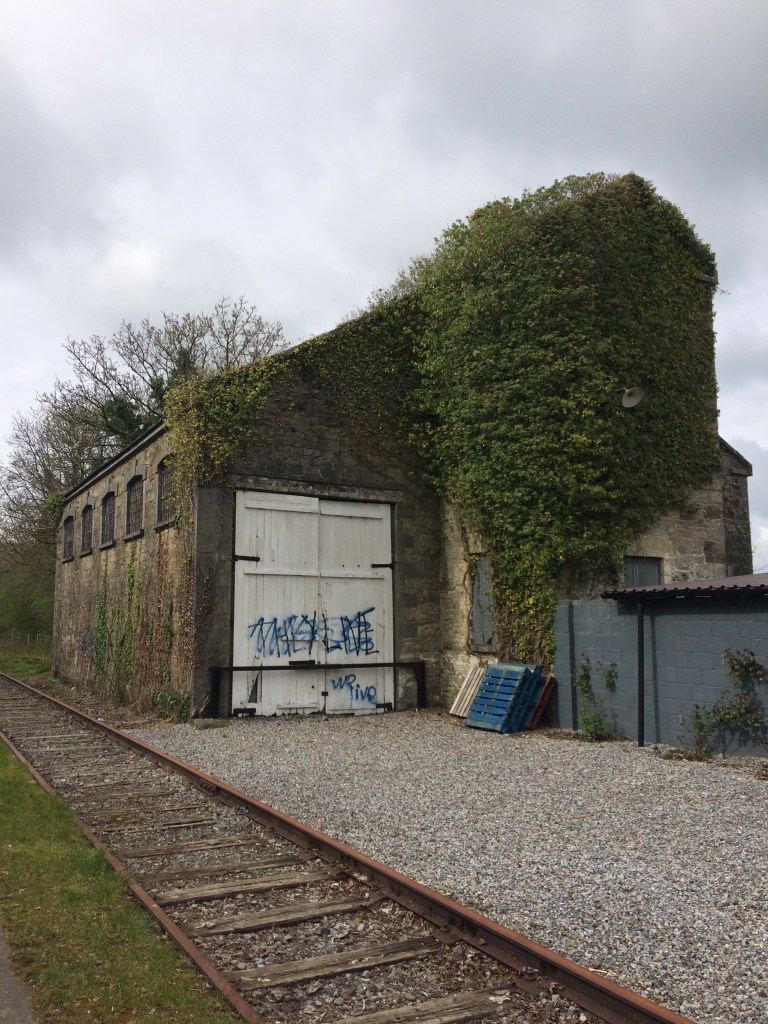
12 replies on “Cycling on the Old Rail Trail: Mullingar to Athlone”
[…] Annex 1: The Old Rail Trail – Mullingar to Athlone […]
LikeLike
[…] Annex 1: The Old Rail Trail – Mullingar to Athlone […]
LikeLike
[…] Annex 1: The Old Rail Trail – Mullingar to Athlone […]
LikeLike
[…] Annex 1: The Old Rail Trail – Mullingar to Athlone […]
LikeLike
[…] Annex 1: The Old Rail Trail – Mullingar to Athlone […]
LikeLike
[…] Annex 1: The Old Rail Trail – Mullingar to Athlone […]
LikeLike
[…] Annex 1: The Old Rail Trail – Mullingar to Athlone […]
LikeLike
[…] Annex 1: The Old Rail Trail – Mullingar to Athlone […]
LikeLike
[…] Annex 1: The Old Rail Trail – Mullingar to Athlone […]
LikeLike
[…] to Galway, the Mullingar to Athlone line hasn’t been used since 1991 and has now become the Old Rail Trail, a 42 kilometre greenway passing through Moate on its way to Athlone and a pleasurable cycle in […]
LikeLike
[…] longest greenway, linking Maynooth to the Shannon at Cloondara with options to also travel the Old Rail Trail to Athlone or take the Longford Branch off the main line to Longford town. Following on from the […]
LikeLike
Great in-depth stories of the canal thanks a million
LikeLike